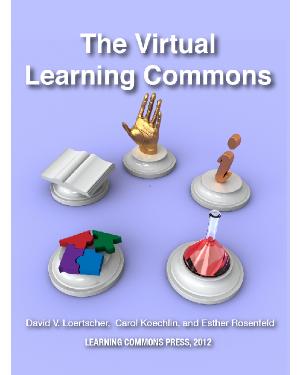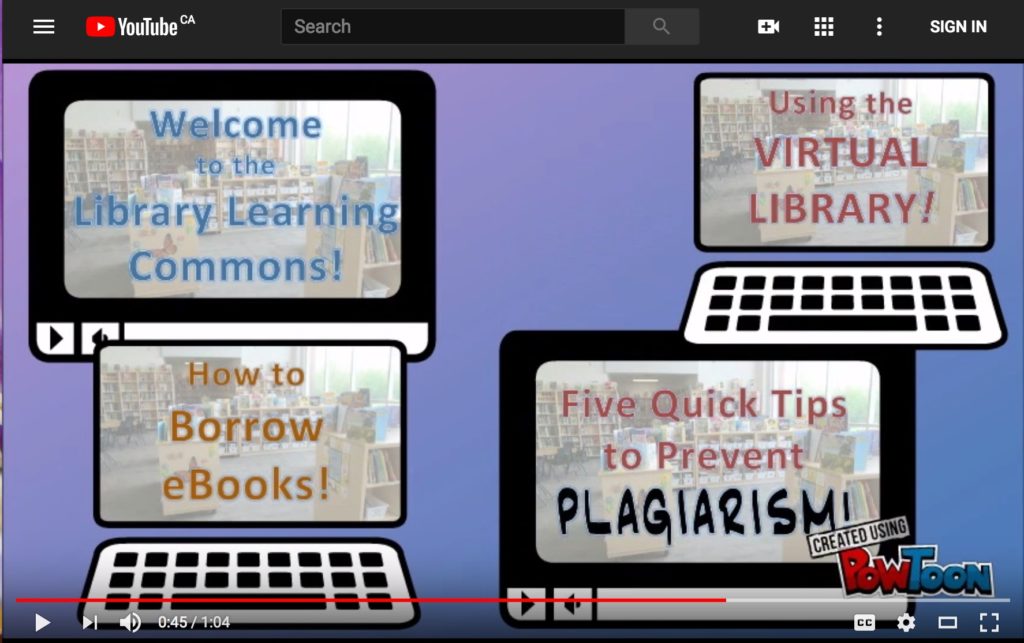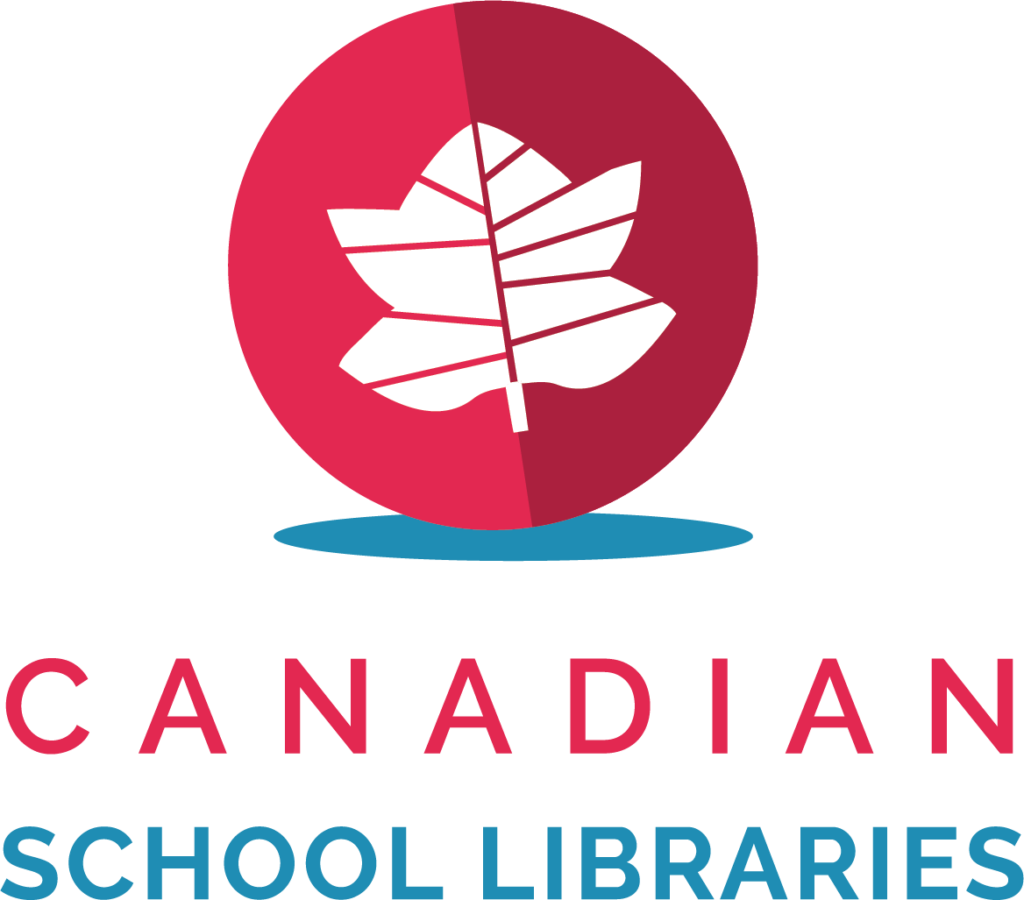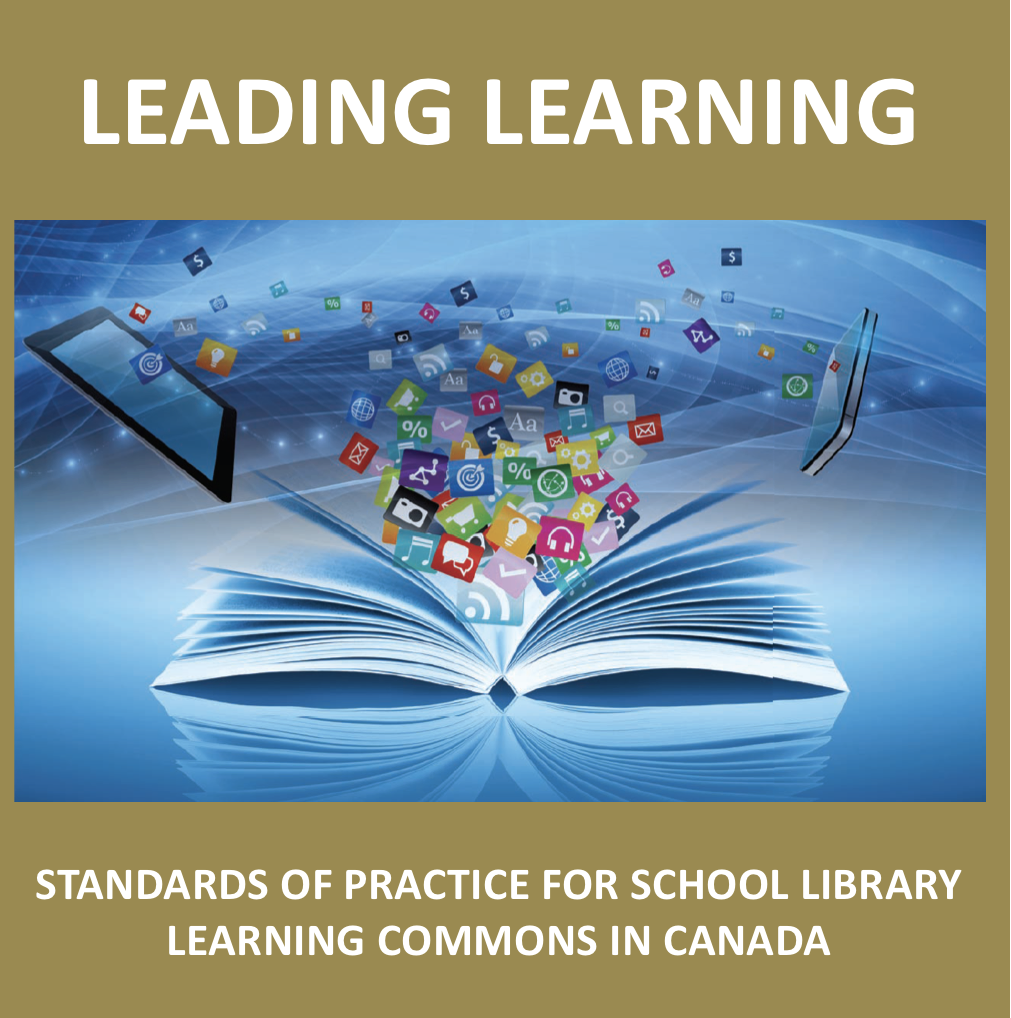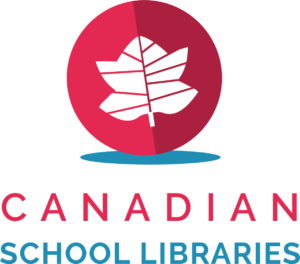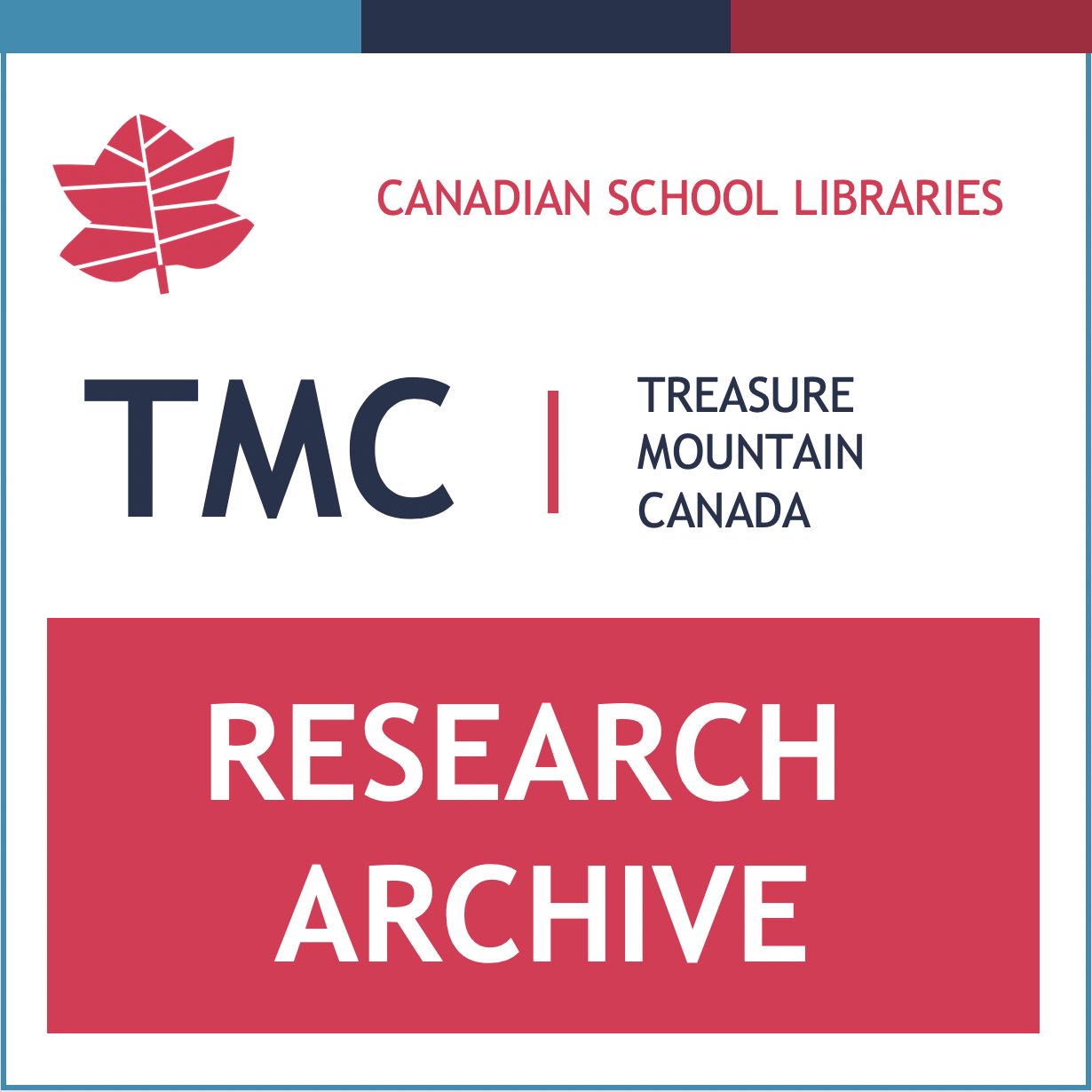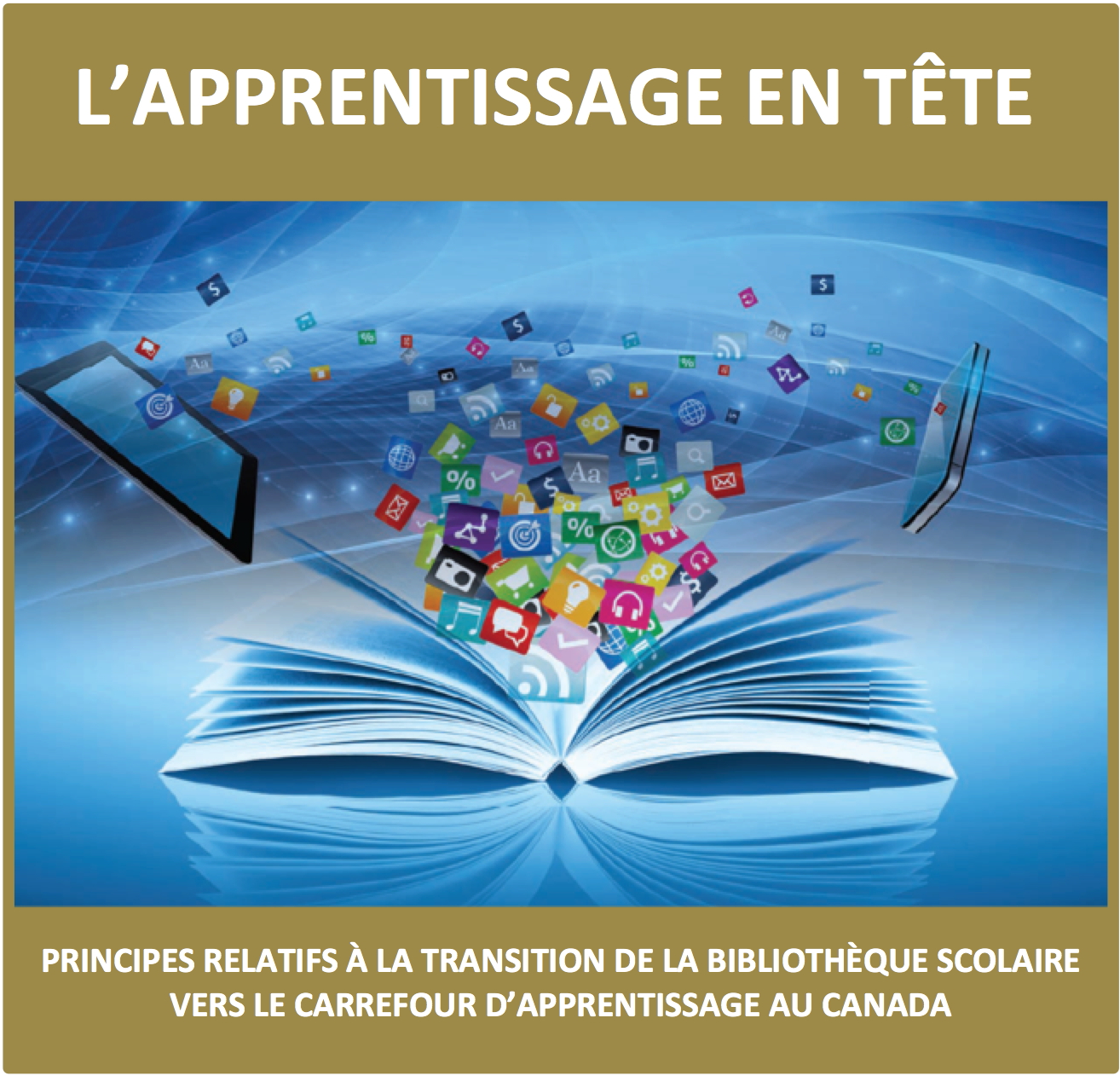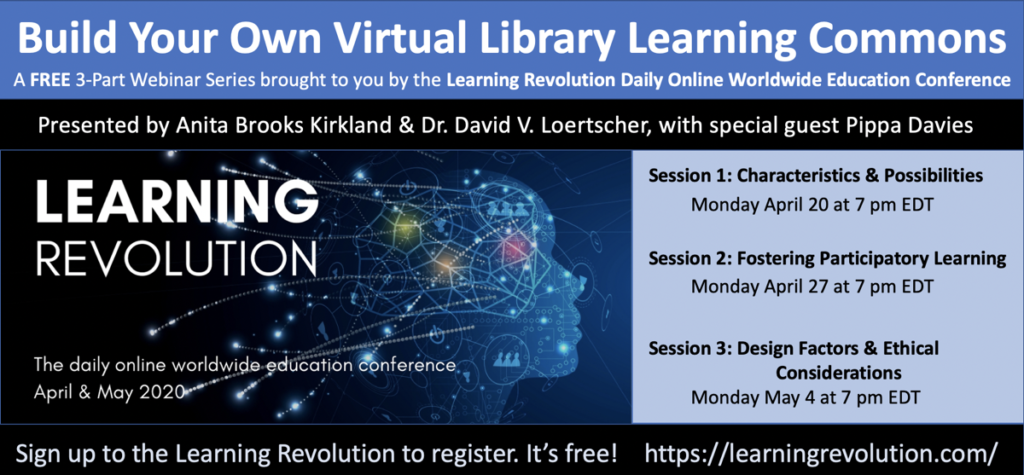
Presenters: Anita Brooks Kirkland, Chair, Canadian School Libraries; Dr. David Loertscher, San José State University School of Information; Pippa Davies, Learning Commons Director, Heritage Christian Online School
It is time to transform the school library website as a one-way push out of links to a school-wide participatory virtual learning community. Yes, the school might have an administrative website for organizational business, and yes, the school may link teachers and students to a content management system, but we imagine a collaborative community building learning experiences, curating content together, doing major design thinking projects, providing a major help center, including not just library resources but art, music, p.e., health, and counselling that create an exciting school culture…the place where students, teachers, and parents click on first.
This is a three-session, participatory webinar:
- Session One: Build Your Own Virtual Library Learning Commons: Characteristics and Possibilities
- Session Two: Build Your Own Virtual Library Learning Commons: Fostering Participatory Learning
- Session Three: Build Your Own Virtual Library Learning Commons: Design Factors and Ethical Considerations
Session One: The Virtual Learning Commons: Characteristics and Possibilities
During this first session, we will spend a bit of time looking at the characteristics and possibilities of a VLLC (Virtual Library Learning Commons); hear the experiences of Pippa Davies who has had a VLLC for some time, and then discuss various platforms that you might use. Finally, we will issue a challenge to come to Session Two about a week later with just the beginnings of your own VLLC. By session three, we hope that you have something up and running that will get the next school year going with a bang.
Connect to the Session 1 Discussion document.
Session 2: Build Your Own Virtual Library Learning Commons: Fostering Participatory Learning
In the first session of this three-part webinar series, we challenged you to get started with building your Virtual Library Learning Commons. In this second session we will explore the possibilities in more detail. How do you use the VLLC to present learning resources? How do you create a collaborative learning environment? How can you create a VLLC that invites student, teacher, and community engagement and demonstrates the efficacy of the school library learning commons program? In this session we invite you to try out some of these ideas as you continue to plan and create your own VLLC.
Special Guests: Melanie Mulcaster & Tina Zita, Peel District School Board
Connect to the Session 2 Discussion document.
Session Three: The Virtual Library Learning Commons: Design Factors and Ethical Considerations
By this session you will have explored the potential of the Virtual Library Learning Commons as a powerful learning tool and collaborative learning space. In this final session we will explore design factors and ethical considerations. Just as we build usability into the physical library design, the ease of use of your virtual space is critical to engaging learners. Part of that is integrating the virtual space across platforms, like the OPAC or the CMS. Ethical considerations like protecting student privacy and complying with licensing and copyright must also be considered when designing virtual spaces. By the end of this session we hope that you have something up and running that will get the next school year going with a bang!
Special Guest: Beth Lyons, Peel District School Board
Connect to Session 3 Discussion document.
Resources
The Learning Commons Guide: Created by Dr. David Loertscher, Fran Kompar, Carol Koechlin and You
Curious about the idea of a Learning Commons, for your K-12 school, that transforms the traditional school library into a vibrant learning community? Here, you will find the current crop of resources to give you lots of ideas and helps created by the authors and other colleagues from the U.S. and Canada. Two major concepts are presented below; but, check out the various tabs for lots of resources and ideas.
The Virtual Learning Commons: Building a Participatory School Learning Community. By David V. Loertscher, Carol Koechlin and Esther Rosenfeld (Learning Commons Press, 2012).
This book sets out the foundational ideas of what a giant participatory Virtual Learning Commons could contribute to teaching and learning in the school, and offers practical advice for achieving associated goals. It deals with some of the important additional issues that are sure to come up as a school launches this grand experiment. Now available as an ebook.
Knowledge-Building Center Guide: Creating Your Own Knowledge-Building Center
Think of this space as a large room where both teacher, teacher librarian, and students can work together. We are creating an interactive learning environment unlike ever before. The sky is the limit, so have fun with this. Connect to this example of a KBC, created by two of Dr. Loetscher’s students.
Virtual Makerspaces: A Resource and Tutorial: Created by Dr. David Loertscher and graduate students at the School of Information, SJSU
A sample Google Site that has been designed for K-12 students who are creative and want to build, invent, and take command of their own learning. It is also a place that teacher librarians and classroom teachers can use to encourage young students to create a product for assignments, but also to develop their expertise around a hobby, interest, or a passion they have created for themselves.
Exploring Digital Horizons within the Culture of the New Learning Commons, by Pippa Davies
This paper reflects the ongoing development, accomplishment and possibilities of a virtual library learning commons in action. Readers will be guided through virtual commons recommended components, growth and support of the author’s provincial curriculum, and we will learn how successfully the virtual learning commons can address diversity in student learning need.
Flip Your Library Orientation: This article by Anita Brooks Kirkland makes the case for flipping library instruction. The virtual library learning commons website can host “flipped” content, freeing up valuable face-to-face time for active and collaborative learning. This “flipped” content is most commonly presented through video and made available online. Face-to-face time is at a premium in the library. We constantly have to repeat basic lessons, like using the catalogue, finding and using databases, and basic search strategies. These kinds of lessons are ideal candidates for building your own body of flipped library video resources.
CMEC (Canada): Copyright Information for Teachers
ALA (United States): Fair Use Guidelines for Libraries
ISTE Standards for Students: I am a Digital Age Learner
Exemplars
Heritage Christian Online School Learning Commons: The virtual library learning commons website built by presenter Pippa Davies and her team.
Thames Valley District School Board Library Learning Commons: The TVDSB uses LibGuides to build central websites: one for secondary schools and another for elementary schools.
Immaculate Conception Catholic Elementary School VLLC: This school is in the Hamilton-Wentworth District School Board, which supports school library websites built with Follett’s Destiny Quest.
Evan Hardy Collegiate VLLC: Saskatoon School District provides LibGuide spaces for all elementary and secondary school libraries to build their individualized virtual library learning commons spaces. A good example of using LibGuides for virtual pathfinders.
Walnut Grove Secondary School VLLC: This school in the Langley School District in British Columbia has an exceptional VLLC.
Bringing the LLC Home: This website from Peel District School Board central library support brings the school library into students’ homes during the pandemic. It is an excellent example of using Google Sites. The site uses a model they call Interactive Choice Grids to present learning provocations to students, supporting them in all aspects of reading engagement, research, making, and design thinking. The site also includes resources for professionals to learn how to make their own choice grids, and many Peel DSB teacher-librarians have contributed their creations to this site, or used the model on their own Virtual Library Learning Commons.
Larkspur PS Virtual Library Learning Commons: Peel DSB teacher-librarian Beth Lyons has created a wonderful VLLC. Check out pages in the Literacy Connection for exemplars of facilitating curation and conversation in the VLLC.
St. Michael Community School Website: Resource Centre: The Regina Catholic School District integrates the library into every school website. The Resource Centre section of the website shares district-wide resources and programs, while providing space for the school’s teacher-librarian to add custom content. Teacher-librarian Anita Hammond is inspired to add content to support the school’s distance learning during the pandemic.
Additional Resources
Canadian School Libraries (CSL) is a non-profit charitable organization dedicated to professional research and education in the field of the school library learning commons in Canada. CSL connects school library practitioners and educators across Canada in the collaborative pursuit of delivering exemplary practices reflective of current professional school library learning commons standards.
The Post-Pandemic School Library Learning Commons: CSL has created this professional collaborative resource to spark innovation about post-pandemic approaches. The resource uses the Knowledge-Building Centre model and may provide a useful exemplar for this approach.
CSL’s resources on Culturally Relevant and Responsive School Library Learning Commons may be useful to guiding actions related to cultural literacy.
Leading Learning: Standards of Practice for School Library Learning Commons in Canada
Leading Learning provides a guide for the transition of school libraries to vibrant centres of teaching and learning responsive to the diverse needs of learners today and into the future. It also serves as a measurement tool to help schools determine where they are now with library facilities and programs and where they want to advance to. Live examples are provided for every standard / theme / growth indicator, in practice in Canadian schools, including great examples of virtual learning commons.
Canadian Children’s Book Centre: The CCBC provides a great example of a literacy partner for all Canadians during the pandemic, providing a master list of virtual access to resources for reading engagement, including author book read-alouds. The CCBC launched its new Bibliovideo YouTube channel in April 2020. Bibliovideo is all about Canadian children’s books, and is continuously updated. Canadian School Libraries is a member of the Bibliovideo consortium.
Inspiration!
Make the World Better from EL Education on Vimeo.

